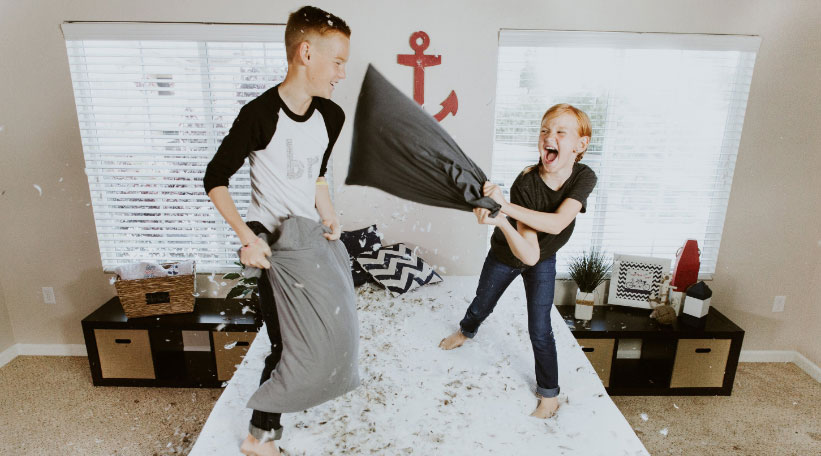Children change so quickly, but their rooms don’t have to…
By Tammy Adamson-McMullen
Most kids’ rooms are in a constant state of change, just like the little ones who occupy them. From pastels and lullaby themes to primary colors and licensed cartoon characters to neons and pop star posters, kids’ rooms are always a work in progress.
But you don’t have to make over your children’s rooms every time they have a growth spurt. With a well-planned and -executed design, you can create rooms that work over time and appeal to your children at every stage of their development. The key? Think “neutral” for the major components of the room, which remain in place, and “personal” for the accessories, which can be cycled out over time.
MAJOR COMPONENTS
Paint
It’s tempting to paint your child’s room in their favorite colors or in hues that match another element of the room, such as a dinosaur bedding ensemble or storybook princess collection. But your child’s preferences and bedroom accoutrements are likely to change many times throughout the years, which means you’ll be doing a lot of repainting.
To avoid constant change-ups, choose soft neutral paint colors instead. Creamy whites, wheat, tan, taupe and gray are perfect backdrops for more colorful accessories and can stay in place even as the accessories change. If your child wants a bit more wall color, try whispery shades of slate blue, sage or blush—classified by color experts as “new neutrals”—which also have longevity. (Another benefit of a neutral color scheme is that it promotes calmness and sleep.)
In addition to a soft color, choose the paint in a soft finish like a pearl or satin, which looks cozier. You might be tempted to use a glossier finish in a kids’ room for its scrubbability and durability. But all better-quality paints will have these attributes across all sheen levels.
Window Treatments
Blinds, shades and shutters are great choices for kids’ rooms because they offer privacy, light control and sophisticated style. Chosen in neutral or natural tones, these treatments can stay in place year after year, while the treatments on top—draperies, curtains and valances—can be changed as needed to match your child’s favorite color, for example, or a new thematic element in the room.
Roller shades work especially well in kids’ spaces because they look “grown-up,” which even the youngest child can appreciate. Additionally, roller shades are available in a variety options that can solve privacy, safety and sleep concerns you might have for your child, from top-down/bottom-up constructions to cordless mechanisms to light-filtering and room-darkening materials. When selecting fabrics for shades, make sure they not only are neutral in color but also classic in pattern—stripes or herringbones, for example—to get the most mileage from them.
Furniture
After your child has graduated from cribs and toddler beds, think seriously about purchasing furniture that can work over the long haul. Try to avoid gimmicky furniture, like princess beds and gas-pump dressers, that will only “speak” to your child for a small time in their lives. Instead, select furniture that is simply or classically styled, allowing accessories to create the themes your child desires.
Natural wood stains and solid-color pieces are the best finish options for longevity. However, if your child insists on brightly colored furniture, select pieces with clean lines, which will allow you to more easily repaint the pieces down the road.
Additionally, try to choose pieces that will adapt as your child grows. If your budget allows and the room can accommodate it, purchase a full-size rather than a twin-size bed. Low platform beds and low-boy dressers are great options because they can be easily accessed by younger children but look stylish for older ones. Another piece that works over time is a height-adjustable table, which can be used as a play surface early on and a study desk once your child is in school.
DECORATIVE ACCESSORIES
Accessories are where you child’s imagination can run wild! It’s important to involve your child in selecting lamps, linens, toss pillows, knick-knacks and other accessories to make sure the room truly feels like their own. Accessories tend to change frequently in a child’s room, so don’t sweat it if your child’s undersea-themed bedroom incorporates a Star Wars lamp and panda pillows.
Of course, nothing personalizes a child’s room like artwork—either their own or purchased pieces that they enjoy. (Child experts note that artwork helps children connect to their space and can help in the formation of their personal identity.) A fun way to add to the artistry in your child’s room is with peel-and-stick artwork, murals and wallpaper. Peel-and-stick products come in a wide range of colors, patterns, themes and special effects that are suitable for children of all ages. You can also find peel-and-stick alphabet letters to incorporate your child’s name within the space.
As your child moves into the teen years, you might consider peel-and-stick white boards, calendars, mirrors or even floor tiles. The beauty of all of these products is that they offer a huge decorative impact—yet are one of the easiest items to replace as your child matures into adulthood.

 Interior Paints
Interior Paints Exterior Paints
Exterior Paints Primers
Primers Stains & Clears
Stains & Clears
 Paint Brushes
Paint Brushes Paint Roller
Paint Roller Paint Trays & Liners
Paint Trays & Liners



